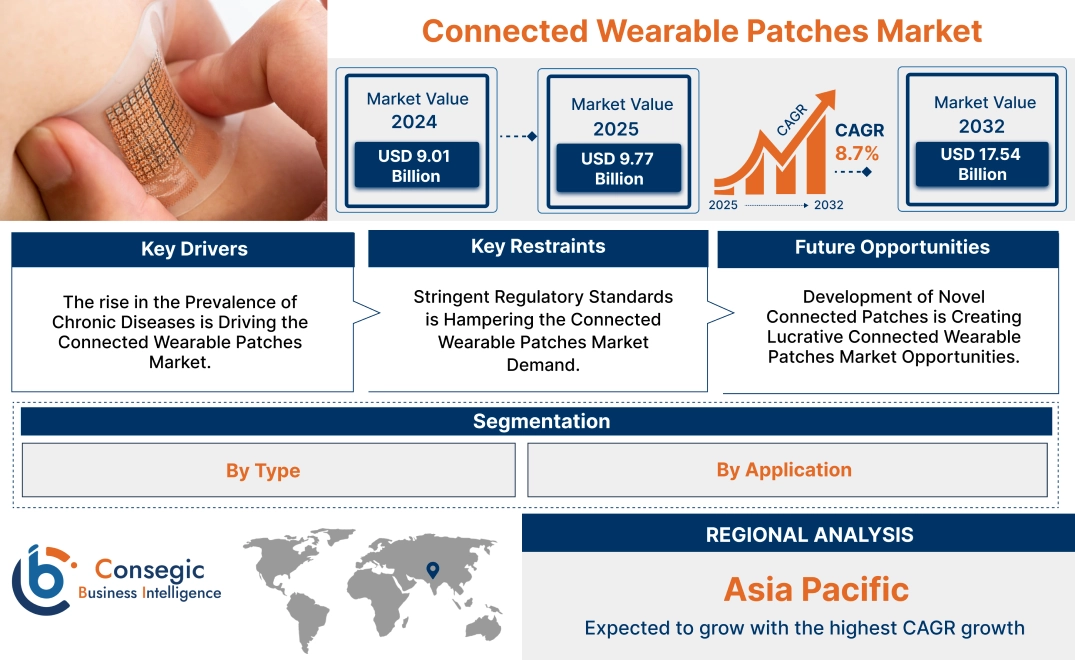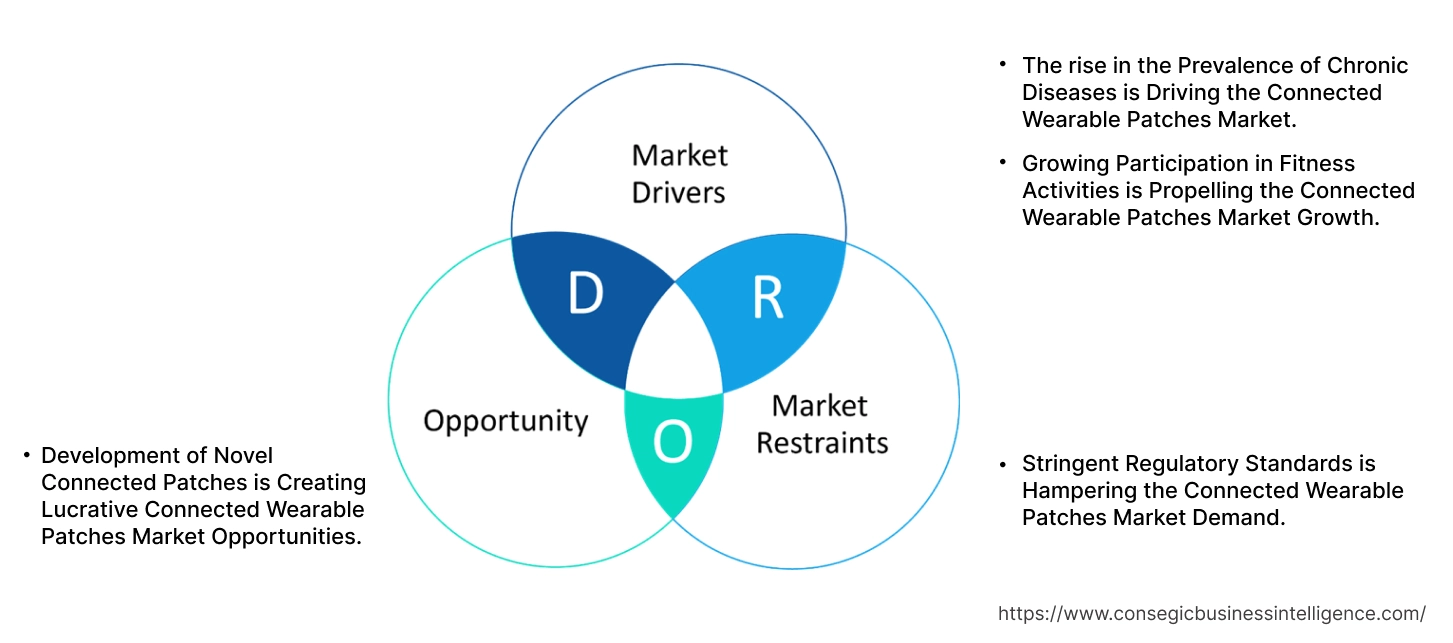Connected Wearable Patches Market Size:
Connected Wearable Patches Market size is growing with a CAGR of 8.7% during the forecast period (2025-2032), and the market is projected to be valued at USD 17.54 Billion by 2032 from USD 9.01 Billion in 2024. Additionally, the market value for the 2025 attributes to USD 9.77 Billion.
Connected Wearable Patches Market Scope & Overview:
A connected wearable patch is a type of wearable device that possesses the additional capability of wirelessly transmitting and receiving data, enabling real-time interaction and remote monitoring. These patches utilize technologies like Bluetooth, near-field communication (NFC), or even cellular connectivity to relay information such as glucose levels, heart rate, temperature, respiratory patterns, or muscle activity to paired smartphones, dedicated receivers, or secure cloud backups. The type includes glucose monitoring patches for diabetes management, cardiac monitoring patches for heart health, electromyography (EMG) patches for muscle activity analysis, transdermal drug delivery patches with controlled release and monitoring, electroencephalography (EEG) patches for brain activity monitoring, and other specialized patches. These patches find their application in remote patient monitoring for chronic disease management and post-acute care, fitness and wellness monitoring for personalized health insights, controlled and monitored drug delivery, sports and performance monitoring for training optimization, and various other healthcare and wellness applications.
How is AI Impacting the Connected Wearable Patches Market?
AI is revolutionizing the connected wearable patches market by transforming them from simple data collectors into intelligent, proactive health monitors. AI algorithms analyze the continuous stream of physiological data from these patches—such as heart rate, glucose levels, and temperature—to detect subtle anomalies and predict potential health issues before they become critical. This enables early intervention for conditions like cardiac events or diabetes. Furthermore, AI enhances personalization by using this data to provide tailored health recommendations and treatment plans. This shift from passive monitoring to active, predictive health management is improving patient outcomes, reducing healthcare costs, and enabling a new era of remote patient care.
Connected Wearable Patches Market Dynamics - (DRO) :
Key Drivers:
The rise in the Prevalence of Chronic Diseases is Driving the Connected Wearable Patches Market.
Connected wearable patches offer continuous and real-time monitoring of vital signs and disease-specific biomarkers, enabling early detection of exacerbations, personalized treatment adjustments, and improved patient engagement in self-management. For chronic conditions like diabetes and cardiovascular diseases, connected patches provide crucial data for proactive intervention, potentially reducing hospitalizations, emergency room visits, and overall healthcare costs. The rise in the prevalence of conditions such as diabetes is influencing the use of these devices.
For instance,
- The data by WHO states that 14% of adults aged 18 years and older were living with diabetes, an increase from 7% in 1990. More than half (59%) of adults aged 30 years and over living with diabetes were not taking medication for their diabetes in 2022.
Thus, the rise in the prevalence of conditions such as diabetes is driving the connected wearable patches market expansion.
Growing Participation in Fitness Activities is Propelling the Connected Wearable Patches Market Growth.
Fitness enthusiasts are increasingly seeking detailed, real-time physiological data to optimize their training, monitor recovery, and prevent injuries. Connected patches offer continuous and non-invasive monitoring of parameters like heart rate, hydration levels, muscle activity (EMG), and others. The growing awareness about the physical and mental health benefits associated with an active lifestyle encourages individuals to participate in fitness activities and use these patches to enhance performance and well-being.
For instance,
- The data published in ptpioneer states that, between 2010 and 2022, daily engagement in physical activity stood at 21.29% for men and 17.07% for women. Women exhibited an increase of 3.5% in their engagement with daily physical activities compared to the previous years.
Thus, the rise in participation in fitness and the requirement for devices that support performance, and wellbeing is driving the market.
Key Restraints:
Stringent Regulatory Standards is Hampering the Connected Wearable Patches Market Demand.
The connected wearable patches industry faces significant hurdles due to stringent regulatory standards imposed by various regulatory bodies worldwide. The classification of these devices as medical devices in many jurisdictions necessitates rigorous pre-market approval processes, involving extensive clinical trials, adherence to quality management systems, and demonstration of safety and efficacy. Compliance with these standards is time-consuming and costly, particularly for smaller companies or those developing novel ingredients.
Additionally, changes in regulatory guidelines or the introduction of stricter regulations disrupt established processes and require significant investments in research, development, and manufacturing to meet the new standards. These factors contribute to increased costs, delayed product launches, and limited market access, ultimately hindering the development of the Connected Wearable Patches industry.
Future Opportunities :
Development of Novel Connected Patches is Creating Lucrative Connected Wearable Patches Market Opportunities.
Advancements in connected wearable patches are rapidly transforming healthcare and wellness by integrating more sophisticated sensors, improved battery life, and enhanced wireless communication. Current trends include the development of multi-parameter patches capable of simultaneously monitoring various vital signs and biomarkers like glucose, cardiac activity, temperature, and even sweat composition. Manufacturers are developing novel connected patches for sweat analysis.
For instance,
- In 2024, Connected Hydration introduced wearable patches and an app providing real-time, personalized sweat analysis (volume, electrolytes), body temperature, and movement data for industrial workers and military personnel. This helps prevent dehydration and heat-related injuries by informing proactive hydration strategies.
Thus, as per the market analysis, the development of novel connected patches is creating connected wearable patches market opportunities in the coming years.
Connected Wearable Patches Market Segmental Analysis :
By Type:
Based on the type, the market is categorized into glucose monitoring patches, cardiac monitoring patches, electromyography (EMG) patches, transdermal drug delivery patches, electroencephalography (EEG) patches, and others.
Trends in the Type:
- There is a growing trend for glucose monitoring patches with smartphones and dedicated apps allow for real-time data visualization, trend analysis, and sharing with healthcare providers.
- Advanced algorithms are being incorporated to improve arrhythmia detection, predict cardiac events, and reduce false positives, enhancing diagnostic accuracy.
The glucose monitoring patches segment accounted for the largest market share in 2024.
Connected glucose monitoring patches are wearable devices that continuously track glucose levels in interstitial fluid and wirelessly transmit this data in real time to smartphones or receivers. A small sensor inserted under the skin measures glucose, and a transmitter sends readings via Bluetooth. This connectivity allows users and healthcare providers to monitor glucose trends, receive alerts for highs and lows, and make informed decisions about insulin dosage, diet, and activity.
Thus, the rise in the use of glucose monitoring patches for conditions like gestational diabetes is influencing the connected wearable patches market demand.
The cardiac monitoring patches segment is expected to grow at the fastest CAGR over the forecast period.
Connected cardiac monitoring patches are a significant subset of cardiovascular monitoring and diagnostic devices. These patches are small, adhesive devices worn on the chest to continuously track heart activity (ECG, heart rate) wirelessly. They offer extended wear times are more comfortable, and transmit data in real-time to healthcare providers via Bluetooth or cellular networks. Manufacturers are introducing novel devices that consist of AI technology.
For instance,
- In 2023, iRhythm launched its next-gen Zio monitor, a smaller, lighter cardiac patch with enhanced long-term continuous monitoring services. It uses advanced AI technology to support ECG data.
Thus, the development of cardiac monitoring patches influences the development of the segment.
By Application:
Based on the application, the market is categorized into remote patient monitoring, fitness and wellness monitoring, drug delivery, sports & performance monitoring, and others.
Trends in Application:
- The increasing user-friendliness of wearable sensors and connected patches is driving greater patient adoption and providing more continuous data streams for remote patient monitoring.
- Connected wearable technology is increasingly being used to monitor biomechanics, identify movement patterns that lead to injury, and provide real-time feedback to athletes and coaches for preventative measures.
The remote patient monitoring segment accounted for the largest Connected Wearable Patches market share of 31.09% in the year 2024.
Connected wearable patches are increasingly vital in remote patient monitoring (RPM) globally. These small, skin-adhered devices continuously track physiological data like heart rate, glucose levels, and respiratory patterns, transmitting it wirelessly to healthcare providers. The growing demand for continuous health monitoring and management for various conditions is driving remote patient monitoring solutions.
For instance,
- According to an MSI International survey, 80% of Americans are in favor of using remote patient monitoring, and nearly one-half are very favorable towards incorporating it into medical care.
Thus, the rise in the demand for remote patient monitoring is influencing the use of connected patches.
The sports & performance monitoring segment is expected to grow at the fastest CAGR over the forecast period.
Connected patches are increasingly utilized in sports and performance monitoring to provide athletes with real-time, in-depth physiological data. These patches continuously track heart rate, respiration, hydration levels, muscle activity, and even body temperature during training and competition. This data allows athletes and coaches to optimize training intensity, monitor fatigue and recovery, prevent injuries by identifying biomechanical issues, and gain insights into performance metrics, ultimately leading to enhanced athletic outcomes and personalized training regimens.
Thus, as per the connected wearable patches market analysis, the requirement for sports & performance monitoring is influencing the connected wearable patches market trends in the coming years.
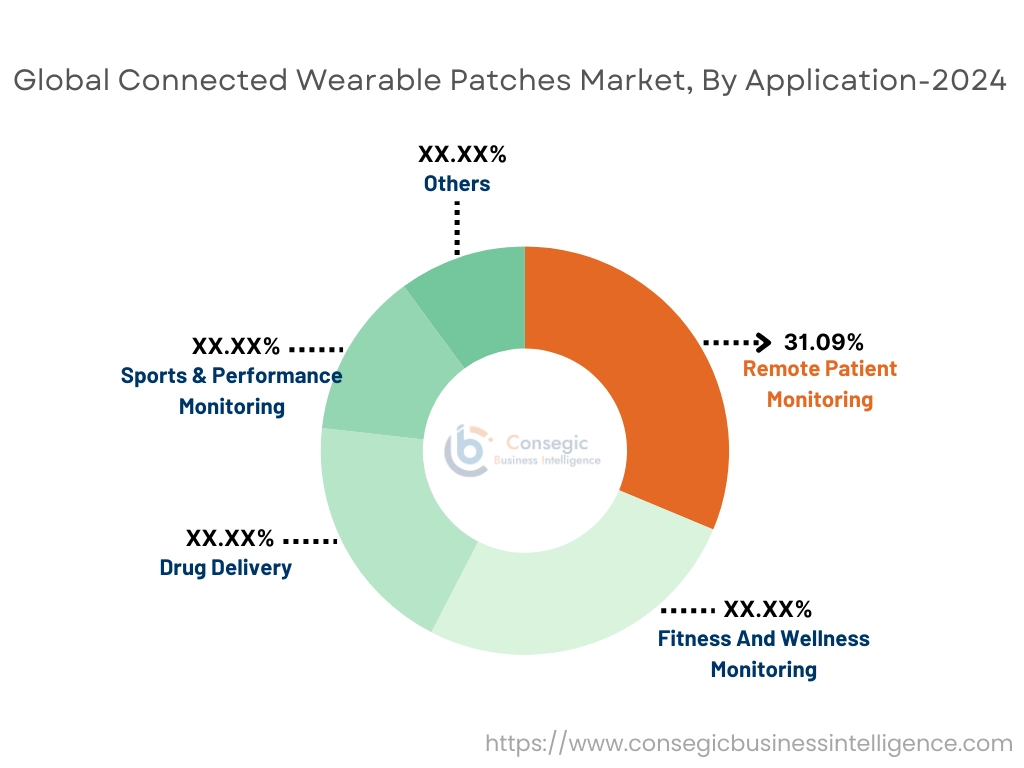
Regional Analysis:
The regional segment includes North America, Europe, Asia Pacific, the Middle East and Africa, and Latin America.
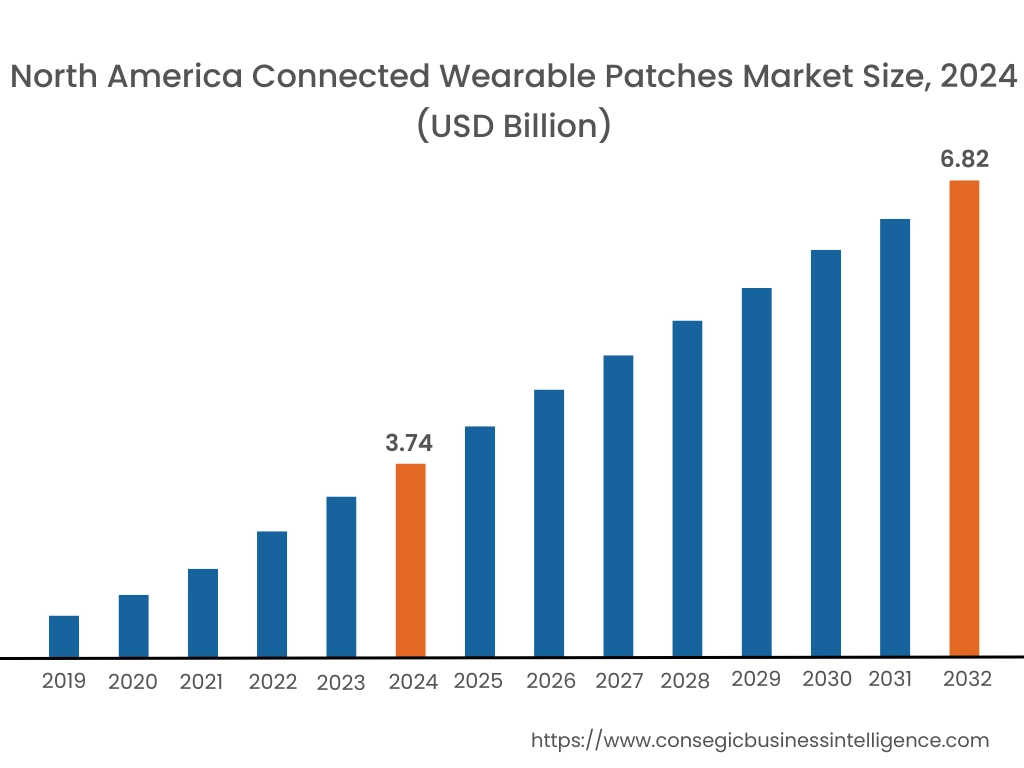
In 2024, North America accounted for the highest Connected Wearable Patches market share at 41.51% and was valued at USD 3.74 Billion and is expected to reach USD 6.82 Billion in 2032. In North America, the U.S. accounted for the highest market share of 72.18% during the base year of 2024. Conditions like diabetes and cardiovascular disorders, affecting a large portion of the population, necessitate continuous and remote monitoring. Connected patches, such as continuous glucose monitors and cardiac monitoring devices are smart medical devices that offer a convenient and effective way to track vital health data in real-time, enabling proactive management, early intervention, and improved patient outcomes across the region. The rise in the prevalence of conditions such as diabetes is influencing the use of connected patches.
For instance,
- The data by USA Facts states that the prevalence of diabetes in the USA has increased from 10.3% of people in 2001 to 11.6% in 2021.
Thus, the rise in the prevalence of chronic conditions such as diabetes is influencing the use of wearable patches.
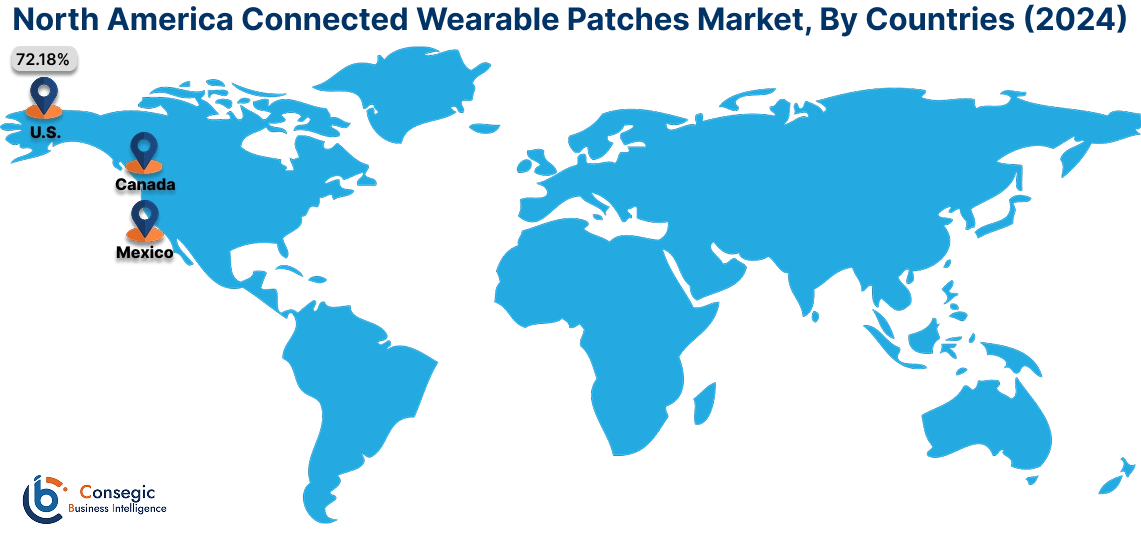
Asia Pacific is experiencing the fastest growth with a CAGR of 10.3% over the forecast period. Advancements in connected wearable devices in the Asia Pacific (APAC) region are rapidly accelerating, driven by strong government support for digital health, increasing smartphone penetration, and a large, health-conscious population in countries like China and India. Miniaturization, enhanced sensor accuracy, and longer battery life are leading to more user-friendly and effective patches. Integration with AI for personalized health insights and the development of multi-parameter monitoring capabilities are key trends. Thus, these factors are influencing the growth of the market in this region.
The European connected patches market is benefiting from a rising health and fitness consciousness. Increased fitness club memberships and a heightened awareness of exercise's holistic benefits, fueled by urbanization and impactful public health campaigns, are creating a strong demand for personal health monitoring solutions. The widespread influence of fitness technology, including sophisticated connected patches, allows individuals to track their physiological data during workouts and daily life. Thus, as per the connected wearable patches market analysis, the rise in participation in fitness activities is influencing the connected wearable patches market expansion.
In the Middle East and Africa region, increasing awareness of diabetes management, rising disposable incomes in some areas, and the growing penetration of mobile technology are creating opportunities. Initiatives focusing on digital health and partnerships aimed at improving access to diabetes technology are beginning to emerge, suggesting potential for future growth in the development and use of advanced connected glucose patches in the MEA region. Thus, the development of connected glucose patches is driving the connected wearable patches market trends in this region.
Remote Patient Monitoring (RPM) application in Latin America is experiencing notable connected wearable patches market growth, driven by the increasing prevalence of chronic diseases and the need to improve healthcare access, especially in remote areas. The market is projected for significant expansion, with increasing adoption of wearable technology and government support signaling a positive growth for RPM in the region. Thus, the rise in the adoption of remote patient monitoring is influencing the growth of the market in this region.
Top Key Players and Market Share Insights:
The global Connected Wearable Patches market is highly competitive with major players providing precise products to the national and international markets. Key players are adopting several strategies in research and development (R&D) and product innovation to hold a strong position in the global Connected Wearable Patches market. Key players in the Connected Wearable Patches industry include-
Recent Industry Developments :
Product Launches:
- In 2024, Connected Hydration introduced wearable patches and app providing real-time, personalized sweat analysis (volume, electrolytes), body temperature, and movement data for industrial workers and military personnel. This helps prevent dehydration and heat-related injuries by informing proactive hydration strategies.
Connected Wearable Patches Market Report Insights:
| Report Attributes | Report Details |
| Study Timeline | 2019-2032 |
| Market Size in 2032 | USD 17.54 Billion |
| CAGR (2025-2032) | 8.7% |
| By Type |
|
| By Application |
|
| By Region |
|
| Key Players |
|
| North America | U.S. Canada Mexico |
| Europe | U.K. Germany France Spain Italy Russia Benelux Rest of Europe |
| APAC | China South Korea Japan India Australia ASEAN Rest of Asia-Pacific |
| Middle East and Africa | GCC Turkey South Africa Rest of MEA |
| LATAM | Brazil Argentina Chile Rest of LATAM |
| Report Coverage |
|
Key Questions Answered in the Report
How big is the Connected Wearable Patches market? +
In 2024, the Connected Wearable Patches market is USD 9.01 Billion.
Which is the fastest-growing region in the Connected Wearable Patches market? +
Asia Pacific is the fastest-growing region in the Connected Wearable Patches market.
What specific segmentation details are covered in the Connected Wearable Patches market? +
Type and Application segmentation details are covered in the Connected Wearable Patches market.
Who are the major players in the Connected Wearable Patches market? +
IRhythm (United States), Medtronic (United States), and VitalConnect (United States) are some of the major players in the market.
